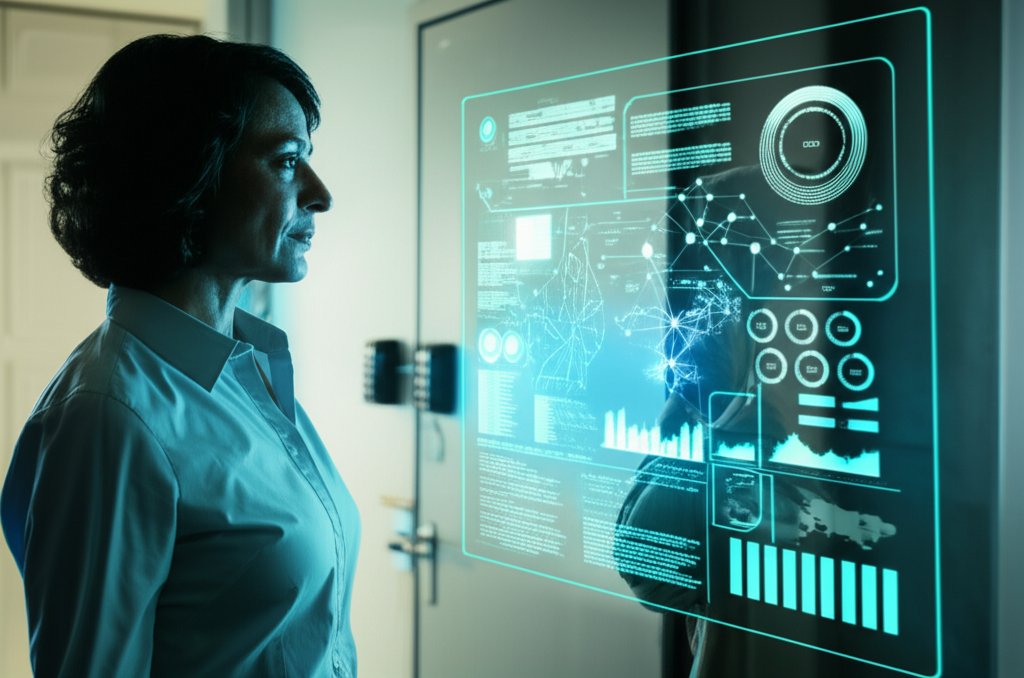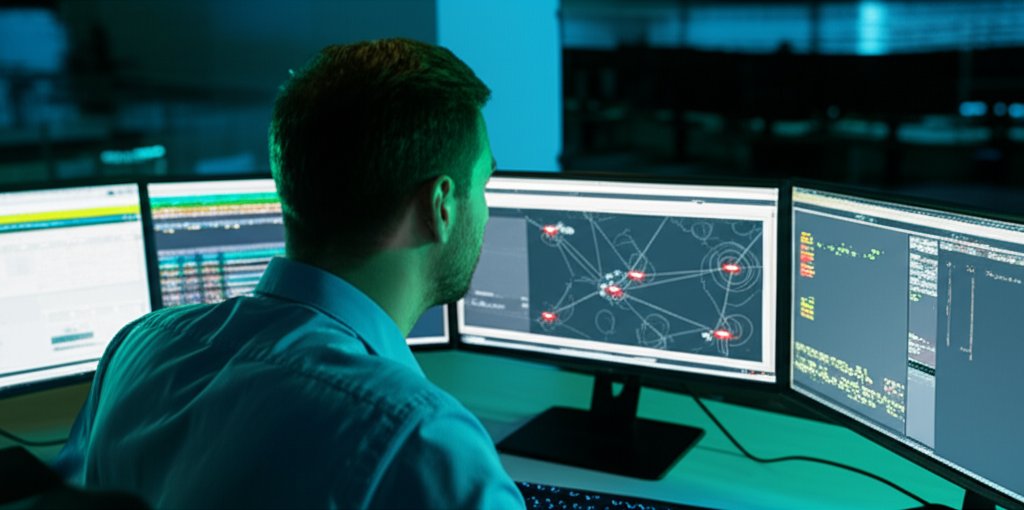The promise of a “digital security superhero” often sounds too good to be true, especially in the complex world of cyber threats. Many small business owners and everyday internet users are led to believe that AI-powered vulnerability scanners are exactly that: a revolutionary, set-it-and-forget-it solution capable of instantly neutralizing every digital risk. Imagine buying a state-of-the-art home security system that not only detects intruders but also learns their patterns and predicts their next move. It’s incredibly advanced. But would you then leave your doors unlocked, skip maintenance, or ignore a complex new threat? Probably not.
This is precisely the nuanced reality of AI-driven vulnerability assessment tools. While they represent a monumental leap forward in our collective ability to identify and address security weaknesses, they are not a magic bullet. They are powerful allies in the ongoing battle for digital security, but their true value emerges when understood and deployed strategically. The goal here isn’t to create alarm, but to empower you with a clear, balanced perspective on these sophisticated tools. We’ll unpack how they work, where they excel in proactive cyber defense, and crucially, their inherent limitations.
By the end of this deep dive, you’ll have the knowledge to make informed decisions about protecting your valuable digital assets, ensuring you leverage automated vulnerability assessment effectively without falling prey to hype. Let’s cut through the noise and discover the real deal behind AI in security scanning.
Table of Contents
- What exactly is an AI-powered vulnerability scanner?
- How does AI improve upon traditional vulnerability scanners?
- What are the primary benefits of AI scanners for small businesses and everyday users?
- Why aren’t AI-powered vulnerability scanners considered a “silver bullet”?
- Can AI scanners detect brand-new, unknown (zero-day) vulnerabilities?
- Do AI scanners eliminate false positives entirely?
- Is the human element still crucial in cybersecurity if AI scanners are so advanced?
- Are AI vulnerability scanners affordable and easy to use for small businesses?
- How can small businesses and individuals effectively use AI scanners as part of their cybersecurity?
- What should I look for when choosing an AI-powered vulnerability scanner?
- Are there any ethical considerations or legal boundaries I should be aware of when using these tools?
- What does the future hold for AI in vulnerability scanning?
Basics (Beginner Questions)
What exactly is an AI-powered vulnerability scanner?
An AI-powered vulnerability scanner is a sophisticated software solution that harnesses artificial intelligence, including advanced machine learning algorithms, to autonomously identify security weaknesses across IT infrastructures. This includes everything from computer systems and networks to web applications and cloud environments. Unlike older, signature-based scanners, an AI scanner learns, adapts, and intelligently identifies potential entry points for cyber threats, making it a critical tool for modern automated threat detection.
Think of it as a highly skilled digital detective. A traditional detective might check a list of known criminals. An AI-powered detective, however, can also analyze vast datasets of past criminal behaviors, predict new methods of attack, and prioritize investigations based on the highest risk. For your online safety, these scanners proactively seek out common security flaws like unpatched software, misconfigured systems, or coding errors that could be exploited by malicious actors. By identifying these issues early, AI scanners enable you to fix them before they become costly security incidents. This capability is fundamental to maintaining a strong cybersecurity posture.
How does AI improve upon traditional vulnerability scanners?
AI significantly enhances traditional vulnerability scanning by moving beyond rigid, rule-based checks and static signature databases. This allows AI scanners to detect more subtle, complex, and emerging threats with greater efficiency and accuracy. They leverage sophisticated machine learning algorithms for security to analyze vast amounts of data, learn from historical vulnerabilities, and even spot anomalous behaviors that might indicate a novel weakness, improving your predictive security analytics.
Traditional scanners are akin to a simple checklist; they can only find what they have been explicitly programmed to look for. AI, conversely, introduces genuine intelligence and adaptability. It can process intricate relationships between system components, understand context, and continuously refine its detection capabilities over time through adaptive threat intelligence. This translates to faster scanning cycles, a notable reduction in irrelevant alerts (false positives), and a much better chance of identifying vulnerabilities that don’t fit conventional patterns. This capacity for continuous learning and improvement is a true game-changer, bolstering your overall cybersecurity posture with more efficient and effective continuous security monitoring.
What are the primary benefits of AI scanners for small businesses and everyday users?
For small businesses and individual users, AI scanners offer substantial advantages by providing advanced protection that is often more manageable and efficient than traditional, labor-intensive methods. They can automate complex vulnerability assessment tasks, intelligently prioritize the most critical issues based on real-world risk, and even suggest specific remediation steps. All of this is achievable without requiring extensive in-house technical expertise, making streamlined security operations a reality.
As a small business owner, you likely juggle numerous responsibilities, and maintaining a dedicated IT security team can be an unaffordable luxury. AI scanners step in as an invaluable virtual assistant, helping you proactively defend against a broad spectrum of cyber threats. They can rapidly scan your website, internal network, or critical applications, pinpointing weaknesses that cybercriminals could exploit. This proactive approach is crucial for preventing costly data breaches, system downtime, or reputational damage – risks that small businesses are particularly vulnerable to. By making sophisticated cybersecurity technologies more accessible and providing cost-effective vulnerability management, AI scanners empower you to enhance your defenses effectively.
Intermediate (Detailed Questions)
Why aren’t AI-powered vulnerability scanners considered a “silver bullet”?
While undoubtedly powerful, AI-powered vulnerability scanners are not a “silver bullet” because they are specialized tools designed for identification, not a comprehensive solution for every cybersecurity challenge. They excel at detecting weaknesses but inherently require human insight, interpretation, and decisive action for effective remediation and overall security strategy. A robust holistic cybersecurity strategy always involves more than just scanning.
Consider it this way: having a cutting-edge alarm system for your home is excellent at detecting intruders. However, it doesn’t automatically lock your doors, fix a broken window, or decide whether to call the police or a private security firm based on the specific threat. Similarly, an AI scanner might accurately report that your website has a particular vulnerability, such as outdated software or a misconfigured server. But it’s *you*, or your IT team, who must apply the necessary patch, reconfigure the server, or update the application code. These tools are also limited by the data they are trained on, meaning they can struggle with entirely novel threats, often termed zero-days. Relying solely on automated scanning leaves significant gaps in your defense perimeter, emphasizing the need for human-led remediation and strategic oversight.
Can AI scanners detect brand-new, unknown (zero-day) vulnerabilities?
While AI scanners are certainly more adaptive and sophisticated than traditional tools, they still face significant challenges in reliably detecting completely brand-new, unknown (zero-day vulnerabilities). Their learning mechanisms are fundamentally based on existing data, patterns, and behaviors. Identifying a truly novel threat that has no prior signature, no behavioral analogue, and no recorded exploit remains an immense hurdle, even for the most advanced AI in zero-day exploit detection.
To use an analogy: imagine teaching a child to identify all known species of fruit. They would quickly learn apples, bananas, and oranges. If you suddenly presented them with a completely undiscovered species of fruit they’d never seen, they might be confused. AI operates similarly; it learns from what it has “observed” and processed. A zero-day exploit is like that undiscovered fruit. While AI can analyze code for subtle anomalies, suspicious patterns, or unusual behaviors that *might* indicate a zero-day, this is not a guarantee of detection. Human threat intelligence, proactive ethical hacking, and diverse security practices remain absolutely essential for discovering these elusive and highly dangerous threats. This is a continuous cybersecurity arms race, where adversaries also leverage AI, necessitating a blend of technology and human ingenuity to detect advanced persistent threats (APTs) and ensure comprehensive threat intelligence fusion.
Do AI scanners eliminate false positives entirely?
No, AI scanners do not entirely eliminate false positives, although they significantly reduce their occurrence compared to traditional rule-based scanners. AI’s advanced ability to learn, differentiate, and contextualize between genuine threats and harmless anomalies dramatically improves accuracy. However, no system is perfectly infallible due to the sheer complexity and dynamic nature of software, networks, and evolving threat landscapes. Therefore, complete false positive reduction is an ongoing goal, not a current reality.
False positives are those frustrating alerts that turn out to be benign. While AI employs learned patterns, contextual understanding, and historical data to make smarter, more informed decisions, it’s still possible for a perfectly legitimate configuration, an unusual but harmless piece of code, or a unique network behavior to trigger an alert. The primary objective of integrating AI is to make these instances much rarer, thereby mitigating security alert fatigue and saving your team valuable time and resources that would otherwise be spent investigating non-existent threats. Nonetheless, a trained human eye is still invaluable for reviewing critical findings, especially when dealing with highly nuanced or custom-built systems, ensuring you maintain a clear and accurate picture of your actual risk level and benefit from precise contextual threat analysis.
Advanced (Expert-Level Questions)
Is the human element still crucial in cybersecurity if AI scanners are so advanced?
Absolutely, the human element remains fundamentally paramount in cybersecurity, even with the most advanced AI scanners and sophisticated security tools. This is because AI, by its very nature, lacks critical human attributes such as intuition, strategic thinking, ethical judgment, and the ability to interpret complex, unstructured information with real-world context. AI serves as a powerful tool that significantly augments human capabilities; it does not, and cannot, replace them. This symbiotic relationship is at the heart of effective human-AI collaboration in cybersecurity.
Consider this: AI can rapidly identify a misconfigured firewall rule or a potential software vulnerability. However, it cannot understand the specific business impact of that vulnerability within the context of your unique operations, nor can it devise the best remediation strategy that aligns with your budget, regulatory compliance, and overall business priorities. Humans are indispensable for interpreting AI’s findings, performing strategic risk assessment, prioritizing actions based on real-world impact, designing a comprehensive, layered defense, and leading effective incident response planning. Furthermore, humans define the ethical boundaries for AI’s deployment, ensure legal compliance, and provide crucial ethical hacking expertise. It’s also vital to remember that cybercriminals are also leveraging AI, creating an evolving arms race that demands continuous human ingenuity, critical thinking, and adaptive learning to stay ahead. The synergy between human intelligence and AI power is where true, resilient security lies.
Are AI vulnerability scanners affordable and easy to use for small businesses?
The landscape of AI vulnerability scanners is rapidly evolving, with many solutions becoming increasingly affordable and user-friendly, especially for small to medium-sized businesses (SMBs). Vendors now offer a variety of flexible pricing models, including freemium options and scalable, cloud-based security solutions specifically designed to meet the needs of smaller organizations. However, it’s true that advanced, enterprise-grade solutions can still be complex and costly, necessitating a careful evaluation of your specific needs and budget to find the right fit for SMB cybersecurity budget optimization.
For you as a small business owner, the objective isn’t to acquire the most expensive or feature-rich scanner on the market, but rather the one that perfectly aligns with your specific assets and operational context. Look for solutions with intuitive interfaces, clear and actionable reporting, and automated suggestions for remediation steps. Many cloud-based security platforms require minimal setup and ongoing maintenance, significantly reducing the burden on limited IT resources. Some even offer seamless integration with other tools you might already be using. Always conduct thorough research, compare features relevant to your digital assets (e.g., web application security scanning, internal network vulnerability management), and consider utilizing a free trial to ensure the solution is a good fit before making a financial commitment. Remember, the ultimate goal is to enhance your security posture without overburdening your finances or overwhelming your team, focusing on effective vulnerability prioritization.
How can small businesses and individuals effectively use AI scanners as part of their cybersecurity?
Small businesses and individuals can maximize the value of AI scanners by integrating them into a broader, layered cybersecurity strategy, rather than viewing them as a standalone, “fix-all” solution. This involves establishing a routine for scanning, diligently understanding the findings, prioritizing remediation, and combining these advanced AI tools with fundamental security practices and vigilant human oversight, driving continuous security improvement.
To effectively leverage AI scanners, you should:
- Regularly Schedule Scans: Make automated vulnerability scanning a routine part of your security hygiene, whether weekly or monthly, to promptly identify new weaknesses as they emerge.
- Understand the Output: Don’t just run a scan and ignore the results. Take the time to review the reports. Most AI scanners provide clear, actionable insights, often prioritizing the most critical vulnerabilities that require immediate attention.
- Prioritize & Remediate: Focus on fixing high-priority issues first. Remember, the scanner identifies, but you or your IT provider must implement the fixes, which is a key part of prioritized vulnerability remediation.
- Combine with Basics: Pair your AI scanner with essential foundational security practices. This includes enforcing strong passwords and multi-factor authentication (MFA), ensuring regular software updates, deploying robust firewalls and antivirus software, and conducting ongoing employee security awareness training.
- Seek Professional Help When Needed: If a vulnerability is too complex for your team to address internally, do not hesitate to consult a cybersecurity professional or a managed security service provider (MSSP).
What should I look for when choosing an AI-powered vulnerability scanner?
When selecting an AI-powered vulnerability scanner, your primary focus should be on features that directly align with your specific digital assets, technical expertise, and budgetary constraints. Prioritize solutions that offer a balance of ease of use, comprehensive coverage, accurate reporting, and reliable customer support. The ideal choice for small businesses and everyday users will blend powerful capabilities with user-friendliness.
Consider these key aspects during your evaluation for effective vulnerability management tools:
- Targeted Coverage: Does the scanner cover the specific assets you need to protect? This might include web application security scanning, network infrastructure, cloud services, or internal systems.
- Accuracy & False Positive Rate: While no scanner is perfect, AI should significantly reduce irrelevant alerts. Look for vendors with a proven track record of high accuracy and low false positive rates.
- User Interface (UI) & Experience (UX): Is the platform intuitive and easy to navigate for someone without extensive technical skills? A clean, well-designed UI can drastically reduce the learning curve.
- Reporting & Remediation Guidance: Does it provide clear, actionable reports with practical, step-by-step instructions for fixing identified issues? Good reporting is crucial for effective actionable vulnerability reports.
- Integration Capabilities: Can it integrate seamlessly with other tools you already use, such as project management systems, developer pipelines, or other security platforms?
- Cost & Scalability: Does the pricing model fit your budget, and can the solution scale effectively as your business grows or your assets expand? Look for transparent and flexible pricing structures.
- Support & Community: Access to responsive customer support or an active user community can be invaluable for troubleshooting, learning, and staying informed about updates.
Are there any ethical considerations or legal boundaries I should be aware of when using these tools?
Yes, absolutely. Using AI-powered vulnerability scanners comes with significant ethical and legal considerations, primarily concerning privacy, responsible data handling, and obtaining proper authorization. It is a non-negotiable requirement that you must always obtain explicit, written permission before scanning any system or network that you do not own, explicitly manage, or have clear contractual rights to assess. This is critical for preventing issues related to unauthorized penetration testing.
Scanning without appropriate permission can be both illegal and highly unethical, potentially leading to severe legal repercussions, including substantial fines and even imprisonment. Such actions are frequently categorized as unauthorized access, attempted hacking, or even malicious activity in many jurisdictions. When deploying these powerful tools, you are held responsible for:
- Obtaining Explicit Consent: Always secure written permission from the system or network owner before initiating any external scans.
- Data Privacy Compliance: Be acutely mindful of any personal or sensitive data that might be inadvertently accessed or collected during a scan. Ensure strict compliance with relevant data protection regulations such as GDPR, CCPA, or other local privacy laws.
- Responsible Disclosure Policies: If, with proper authorization, you discover a significant vulnerability in someone else’s system, you have an ethical and often legal obligation to disclose it responsibly. This means informing the owner privately and allowing them ample time to fix the issue before any public disclosure.
- Preventing Tool Misuse: Remember that AI scanners are sophisticated, powerful tools. They must only be used for legitimate, defensive cybersecurity purposes, strictly within established legal and ethical boundaries.
Professional ethics and legal compliance are not optional considerations; they are foundational pillars of responsible cybersecurity practices and the use of these advanced technologies.
What does the future hold for AI in vulnerability scanning?
The future of AI in vulnerability scanning is exceptionally promising, with ongoing advancements poised to bring even greater automation, enhanced predictive capabilities, and deeper integration across the entire software development lifecycle. We can anticipate AI tools evolving to become significantly more proactive, capable of identifying potential weaknesses and misconfigurations much earlier—perhaps even before lines of code are finalized, ushering in an era of AI-driven secure development lifecycle (SDLC).
We can expect AI to continue its evolution in several key areas:
- Enhanced Predictive Analysis: AI will become increasingly adept at predicting where vulnerabilities are most likely to appear based on complex code patterns, developer behaviors, and environmental factors, leading to highly accurate predictive vulnerability identification.
- Self-Healing Systems: Imagine future systems where AI could not only detect but also automatically generate and apply patches or configuration changes for certain classes of vulnerabilities, creating a new paradigm for rapid remediation.
- Deeper Contextual Understanding: AI will gain a more profound understanding of business logic, application context, and operational criticality, resulting in even fewer false positives and significantly more relevant and impactful findings.
- Offensive & Defensive AI Arms Race: As defensive AI continues to improve, so too will offensive AI leveraged by adversaries. This dynamic will necessitate continuous innovation and adaptation in both defensive strategies and technologies, creating an ongoing need for human oversight in autonomous threat hunting.
For you, this means access to increasingly sophisticated tools to safeguard your digital presence. However, the core principle will endure: AI is a powerful and indispensable assistant, but it remains a tool—not a substitute for human vigilance, strategic planning, and a comprehensive, adaptive security strategy.
Related Questions
- How can I set up a basic cybersecurity defense for my small business without a huge budget?
- What are the most common types of cyberattacks small businesses face today?
- How often should I be performing security audits or scans on my systems?
- What role do strong passwords and multi-factor authentication play alongside AI scanners?
- Can AI help me understand complex security reports better?
The Verdict: AI Scanners as a Powerful Tool, Not a Panacea for Digital Security
So, are AI-powered vulnerability scanners the fabled “silver bullet” for all your digital security woes? The truth, as we’ve thoroughly explored, is a resounding “no.” Yet, this measured assessment does not diminish their incredible, transformative value. These tools are, without a doubt, a potent weapon in your cybersecurity arsenal, offering speed, accuracy, and efficiency in proactive cyber threat mitigation that traditional methods simply cannot match. For small businesses and individual users, they democratize access to advanced threat detection capabilities, helping to level the playing field against increasingly sophisticated and well-resourced cybercriminals.
However, it’s crucial to remember that AI scanners are just that – tools. They are exceptionally powerful, certainly, but tools nonetheless. They excel at identifying problems; they do not automatically fix them. They learn from vast datasets and patterns; they cannot intuitively grasp or predict entirely novel threats with no prior analogue. They automate processes; they cannot replace the strategic thinking, ethical judgment, contextual understanding, and holistic human oversight that only experienced professionals can provide. Your journey to robust digital security isn’t about finding one magical solution; it’s about diligently building a resilient, layered security architecture that combines the best of cutting-edge technology with human intelligence and unwavering vigilance.
Embrace AI-powered vulnerability scanners for their unparalleled strengths in proactive detection, intelligent prioritization, and efficiency. But always integrate them into a comprehensive security strategy that includes fundamental security practices, continuous learning, and indispensable human oversight. Empower yourself to secure your digital world. Start with resources like TryHackMe or HackTheBox for legal practice, and continue to learn and adapt your defenses.









